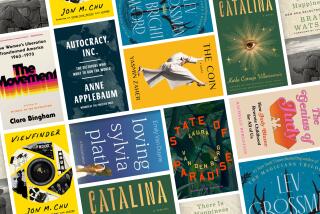The beauty of keeping it brief
- Share via
I’VE always been a sucker for a small book, the kind you can read in a single sitting, a pamphlet or a chapbook, so slender, so discrete. That’s why I like Buk America, the Hollywood-based imprint that got its start in 2005 publishing pamphlets (5-by-7 inches, 16 to 32 pages) in curated sets of six.
The point, Buk’s website tells us, is to offer “one provocative essay, short story, portfolio of pictures, collection of poems or other surprising entertainment, readable in the time it takes to drink a cup of coffee.” The fourth set is just out, and its, er, buks can be purchased individually for $1.49 or together in a nifty little red cardboard “Bukcase” for $11.95.
Of course the Buk idea is a gimmick, but it’s a gimmick that works. Where else would you find, say, Bram Stoker’s “Dracula’s Guest,” Dave Hickey’s “Liberace: A Rhinestone as Big as the Ritz” or “The Constitution of the United States” juxtaposed against one another, like the jumbled thoughts of the collective consciousness?
Buk’s new set of titles is equally eclectic, featuring Charles Baudelaire’s “Transcendence and Other Poems,” Bertrand Russell’s 21-word illustrated fable “History of the World in Epitome” (“Since Adam and Eve ate the apple, man has never refrained from any folly of which he was capable. The end,” it reads in its entirety) and Peter Hujar’s photo collection “Animals.” Best of all is “The Telephone,” a deft little meditation on technology and style by the essayist Akiko Busch.
According to Buk, these pamphlets provide a way for busy people to keep their hands in, to find new ways in which to read. More to the point, they seem to fill a gap left increasingly by magazines, which rarely publish this type of material anymore. Either way, there’s something smart and unexpected about this project, the way each slipcased set of pamphlets freely mixes the old and new, the classic and the cutting edge. If nothing else, it reminds us that good writing comes in all sorts of packages, and that it never goes out of style.
-- David L. Ulin
--
Author versus translator
In considering Rajaa Alsanea’s novel “Girls of Riyadh,” the London Times Literary Supplement complained about the book’s use of tedious cliches in describing the world of young Saudi women.
A letter in the Sept. 28 issue of the TLS from Marilyn Booth, who translated the novel into English, explains what may have really gone on.
Reviewer Stephen Henighan, she writes, “is correct about the English text’s shortcomings. . . . When I submitted the translation . . . I was informed that the author intended to rewrite it, and thereafter I was kept entirely out of the process. The resulting text, with its cliched language, erasures of Arabic idioms I had translated, and unnecessary footnotes, does not reflect the care that I took to produce a lively, idiomatic translation.”
The most troubling thing about Booth’s letter, however, is what it suggests about the conditions under which many translators work today. Booth, director of the University of Illinois’ program in South Asian and Middle Eastern Studies, evokes a demeaning, combative relationship with publishing houses. “Perhaps the larger scandal, “ she declares, “. . . is that for some publishers and writers, literary translators remain derivative servitors rather than creative artists, a notion fostered by a long tradition within Euro-American letters of the writer as solitary genius and translation as a mechanical exercise.”
-- Nick Owchar
For more Jacket Copy, visit us online at: latimesblogs.latimes.com/jacketcopy.
More to Read
Sign up for our Book Club newsletter
Get the latest news, events and more from the Los Angeles Times Book Club, and help us get L.A. reading and talking.
You may occasionally receive promotional content from the Los Angeles Times.








